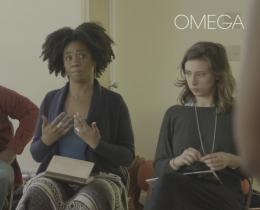Omega: What was your entry into yoga and how has it impacted your life?
Tamara: I remember being little and watching Lilias Folan on television. She was my first intro to yoga and I was fascinated by her long braid of hair, but of course I wasn’t practicing back then. In the 1980s, I was exploring off and on, practicing at home. I bought a few books and that eventually led to me to sign up for a teacher training.
I didn’t think I would ever teach; I just wanted to learn more and deepen my practice. But during my training, I would talk to people when I was out and about and they would share that they were interested in yoga, too. I would recommend a good studio to try, and they would say something like, “Let me know when you’re going to teach.” I was talking to middle-aged black women and they wanted me to be the teacher. I thought that was interesting.
I slowly started taking teaching opportunities here and there. I got more encouragement from a colleague at Bennett College, which is a historically black women’s liberal arts college. We wanted yoga to be a credit course on campus. It took some time to get it in the catalog, but by the time it happened, I had finished my training.
We offered an 8:00 a.m. class on Tuesday and Thursday, and I thought we would need at least 10 people to keep the course. The day after registration both classes were full—with 70 people signed up. Every semester I’ve taught these classes, they fill up instantly. People come to my class begging me to open a spot. They come with tears in their eyes saying, “Can you please take one more person?”
Because it’s a course, I assign my students to write a research paper on the benefits of yoga. A large majority of students choose to look at yoga for depression and/or anxiety, and many of them say they are writing about it because they deal with it. So that got me interested in taking an informal survey and researching more. In my classes, 56 percent of students said they had experienced or were experiencing depression or anxiety.
I mentioned it to my colleague Santiba Campbell, a psychology professor and she said, “Let’s do a real survey and make it official.” We are presenting our findings at the 2017 Yoga Service Conference.
Omega: Can you talk more about how you adapt yoga for every body and age?
Tamara: I’ve learned a lot and had a few surprises. I teach a very intro level course with basic poses so that it’s accessible to all. I walked into teaching yoga at Bennett knowing that I had to be conscious of body types. My class has lots of different shapes and levels of athleticism, so I had to be mindful of that. Some of my bigger girls have such beautiful form. My 12-year-old daughter will come to class and she’s a skinny thing who can hardly touch her toes. So, we know yoga is not about body size.
Many students consider themselves Christian so I let them know that yoga doesn’t conflict with their religion. It surprised me that some people were a bit nervous about hearing Sanskrit words. From Day 1, I tell them that Sanskrit is a language and it’s not going to interfere with their spiritual beliefs and I will mostly use the translations when calling poses.
In my classes we don’t chant, but we do meditate. I have set up the meditation so that people understand it and the way that I translate it for them is that prayers are a way of asking, while mediation is about listening for answers. I remind them that they can bring this practice to their spiritual tradition.
Omega: Do you have any advice or motivation for those just starting out?
Tamara: I like what Judith Lasater says, which is commit to doing three poses every morning. If you get out of bed and stand up, you’ve got standing pose (Tadasana). And then you can sit down and you’ve got easy pose (Sukhasana). If you do one more pose, you are good for the day. It doesn’t have to require hours in meditation or asana practice. You can start with one or two good poses a day or three minutes of breathing, and that’s good enough. I think a lot of people have a fear that if they go to a space and see everyone else contorting like pretzels that they won’t be able to do that, but it doesn’t have to be like that at all.



